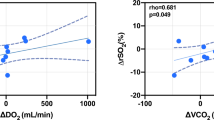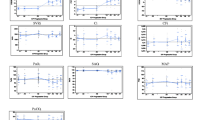Summary
Both metabolic rate and protein catabolism are known to increase following severe head trauma, but the etiology of this hypermetabolism is unknown. To further investigate the problem, we studied the metabolism of 17 patients with indirect calorimetry who had severe craniocerebral trauma only and who required ICP monitoring for management. Patients were studied daily and immediately after ICP spikes greater than 20 mmHg, prior to treatment with hyperventilation, osmotic diuretics, or barbiturates. Oxygen consumption (VO2) was correlated with ICP. Two groups of patients were identified. Group I patients were treated with hyperventilation and osmotic diuretics while Group II patients additionally received cerebral metabolic depressants. Group I had a significant correlation coefficent between VO2 and ICP. Significant hypercatabolism early in the post trauma period was demonstrated by increased urine urea nitrogen. Our observations suggest that in patients with craniocerebral trauma, elevated ICP is associated with increased oxygen consumption, protein catabolism and systemic hypermetabolism. Cerebral metabolic depressants blunted increases in VO2 which were seen with elevated ICP.
Similar content being viewed by others
References
Bartlett RH, Dechert RE, Mault JR, Clark SF (1984) Metabolic studies in chest trauma. J Thorac Cardiovasc Surg 87: 503–508
Bartlett RH, Dechert RE, Mault JR, Ferguson SK, Kaiser AM, Erlandson EE (1982) Measurement of metabolism in multiple organ failure. Surgery 92: 771–779
Bucci MN, Dechert RE, Arnoldi DK, Campbell J, McGillicuddy JE, Bartlett RH (1986) Metabolic requirements in patients with severe craniocerebral trauma. Surg Forum 37: 524–536
Clifton GL, Robertson CS, Choi SC (1986) Assessment of nutritional requirements of head-injured patients. J Neurosurg 64: 895–901
Clifton GL, Robertson CS, Contant CF (1985) Enteral hyperalimentation in head injury. J Neurosurg 62: 186–193
Clifton GL, Robertson CS, Grossman RG, Hodge S, Foltz R, Garzac (1981) The metabolic response to severe head injury. J Neurosurg 60: 687–696
Clifton GL, Ziegler MG, Grossman RG, (1981) Circulating catecholamines and sympathetic activity after head injury. Neurosurgery 8: 10–14
Deutschman CS, Konstantinides FN, Cera FB (1986) Hypermetabolism is not persistent in closed-head injury. Crit Care Med 14: 336
Deutschman CS, Konstantinides FN, Raup S, Thienprasit P, Cerra FB (1986) Physiological and metabolic response to isolated closed-head injury. J Neurosurg 64: 89–98
Drew JH, Koop CE, Grigger AB (1947) A nutritional study of neurosurgical patients. J Neurosurg 4: 7–15
Fruin AH, Taylon C, Pettis MS (1986) Caloric requirements in patients with severe head injuries. Surg Neurol 25: 25–28
Hadley MN, Graham TW, Harrington T, Schiller WR, McDermott MK, Posillico DB (1986) Nutritional support and neurotrauma: a critical review of early nutrition in forty-five acute head injury patients. Neurosurgery 19: 367–373
Kresowick TF, Dechert RE, Mault JR, Arnoldi DK, Whitehouse WM, Bartlett RH (1984) Does nutritional support affect survival in critically ill patients? Surg Forum 35: 108–110
Rapp RP, Young B, Twyman D, Bivins BA, Haack D, Tubbs PA, Bean JR (1983) The favorable effect of early parenteral feeding on survival in head-injured patients. J Neurosurg 58: 906–912
Turell DJ, Alexander JK (1964) Experimental evaluation of Weir's formula for estimating metabolic rate in man. J Appl Physiol 19: 946–948
Turner Jr WW (1985) Nutritional considerations in the patients with disabling brain disease. Neurosurgery 16: 707–713
Twyman D, Young AB, Ott L, Norton JA, Bivins BA (1985) High protein enteral feedings: a means of achieving positive nitrogen balance in head injured patients. J P E N 9: 679–684
Waters DC, Kocan MJ, Dechert RE, Bartlett RH (1984) Metabolic studies in head injury patients. Surg Forum 35: 482–483
Young B, Ott L, Norton J, Tibbs P, Rapp R, McClain C, Dempsey R (1985) Metabolic and nutritional sequellae in the non-steroid treated head injury patient. Neurosurgery 17: 784–791
Author information
Authors and Affiliations
Rights and permissions
About this article
Cite this article
Bucci, M.N., Dechert, R.E., Arnoldi, D.K. et al. Elevated intracranial pressure associated with hypermetabolism in isolated head trauma. Acta neurochir 93, 133–136 (1988). https://doi.org/10.1007/BF01402895
Issue Date:
DOI: https://doi.org/10.1007/BF01402895




